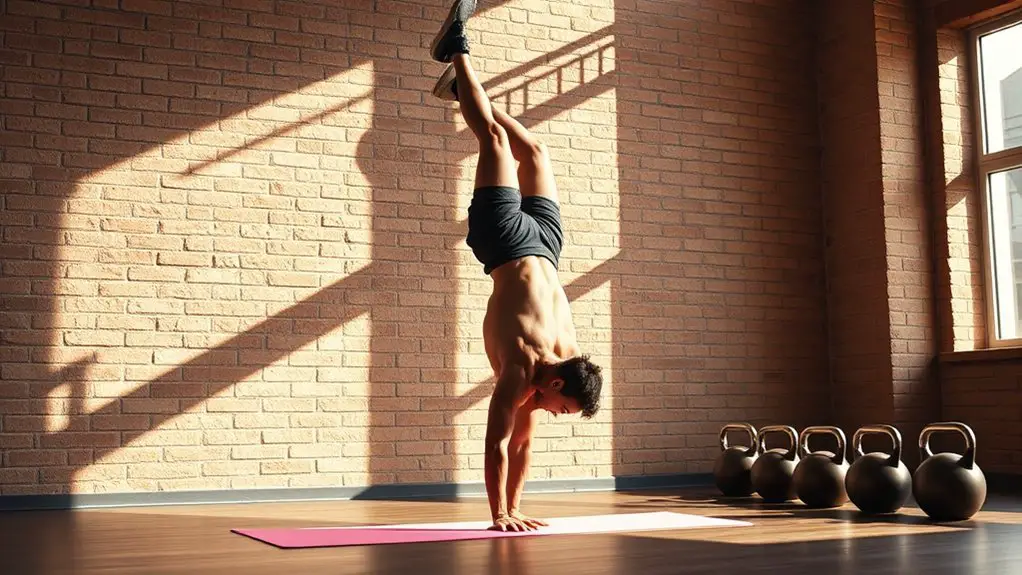Strengthening your hamstrings is key for better pedal power in cycling. These muscles support your efficiency and stability, especially on climbs and long rides. Incorporate exercises like deadlifts and leg curls to boost strength, while dynamic and static stretches improve flexibility. Remember, a strong core enhances stability, too. Prioritize nutrition for recovery, and always track your progress. If you want to learn more about optimizing your hamstring health, there's plenty more to explore.
The Role of Hamstrings in Cycling Performance
While many cyclists focus on their quads, hamstrings play an essential role in cycling performance. When you pedal, your hamstring function contributes greatly to your cycling efficiency. These muscles work in harmony with your quads, helping to stabilize your movements and maintain a smooth cadence. If you ignore your hamstrings, you might find yourself struggling to push through those challenging climbs or lengthy rides. Strengthening exercises for the hamstrings, such as deadlifts and bridges, can enhance your power output and reduce the risk of injury.
Understanding Hamstring Anatomy
To fully appreciate the role of hamstrings in cycling, it's vital to understand their anatomy. Your hamstrings consist of three main muscle groups: the biceps femoris, semitendinosus, and semimembranosus. Each plays a significant role in hamstring function, working together to facilitate movement and power. Their muscle fibers are designed for both strength and endurance, enabling you to pedal efficiently over long distances. A strong core also supports the pelvis during cycling, enhancing stability and balance for improved performance.
| Muscle Group | Function | Key Characteristics |
|---|---|---|
| Biceps Femoris | Flexes knee, extends hip | Longest, powerful fibers |
| Semitendinosus | Flexes knee, assists hip flexion | Thin, endurance-focused |
| Semimembranosus | Flexes knee, stabilizes pelvis | Strong, supportive fibers |
Understanding your hamstrings allows you to harness their potential, giving you the freedom to cycle with greater power and efficiency. Embrace this knowledge, and feel the difference in your ride!
Common Hamstring Injuries in Cyclists
As a cyclist, you might experience different types of hamstring strains, each with its own symptoms. Understanding these injuries is essential for preventing them and keeping you on the bike. Let's look at how you can recognize these issues and adopt effective prevention strategies.
Strain Types and Symptoms
Understanding the types of hamstring strains and their symptoms is crucial for cyclists aiming to maintain peak performance. Recognizing these strain symptoms can help you address issues early, paving the way for effective injury prevention. Here's a quick overview:
| Strain Type | Symptoms | Recovery Time |
|---|---|---|
| Mild (Grade I) | Minor pain, tightness | 1-3 weeks |
| Moderate (Grade II) | Moderate pain, swelling | 3-6 weeks |
| Severe (Grade III) | Severe pain, inability to walk | 3-6 months |
| Chronic | Persistent discomfort | Varies |
| Re-injury | Similar to initial symptoms | Varies |
Stay in tune with your body to keep those pedals spinning smoothly!
Prevention Strategies for Injuries
Recognizing the types of hamstring strains is just the first step in injury management. To truly embrace the freedom of cycling, you'll want to focus on injury prevention strategies that keep you on the road. Here are some effective ways to protect your hamstrings:
- Incorporate dynamic stretches before rides.
- Gradually increase your mileage and intensity.
- Use proper bike fit to reduce strain.
- Apply rehabilitation techniques like foam rolling post-ride.
Benefits of Strengthening Hamstrings
Strengthening your hamstrings can greatly enhance your cycling performance and overall leg strength. When you focus on these muscles, you'll experience a boost in cycling efficiency, allowing you to ride longer and stronger. Here are some hamstring benefits that can help you reveal your true potential:
| Benefit | Description | Impact on Cycling |
|---|---|---|
| Improved Power Output | Stronger hamstrings generate more force. | Better acceleration and speed. |
| Enhanced Endurance | Increased stamina for long rides. | Ride longer with less fatigue. |
| Reduced Injury Risk | Balanced muscle strength prevents strains. | Stay injury-free while cycling. |
| Better Posture | Corrects alignment during pedaling. | More comfortable rides. |
Additionally, prioritizing joint health is essential for optimizing your cycling performance and reducing the risk of injury.
Effective Hamstring Exercises for Cyclists
To boost your cycling performance, it's crucial to focus on effective hamstring exercises. You'll want to incorporate both strength-building movements and stretching techniques into your routine. Let's explore some key exercises that can help you develop cycle-specific strength and flexibility.
Key Hamstring Strengthening Exercises
While cycling can build impressive leg strength, incorporating targeted hamstring exercises into your routine can considerably enhance your pedal power. Strengthening your hamstrings will not only improve your performance but also reduce the risk of injury. Here are some key exercises to contemplate:
- Isometric Exercises: Try wall sits to engage your hamstrings without joint strain.
- Deadlifts: These are fantastic for building overall strength and focus on your hamstrings.
- Leg Curls: Use a machine or resistance bands for effective isolation.
- Dynamic Stretches: Incorporate leg swings to activate your muscles before a ride.
Engaging in these exercises regularly will give you the freedom to ride longer and stronger, feeling the wind on your face and the power in your legs!
Incorporating Stretching Techniques
Incorporating effective stretching techniques into your routine can greatly enhance your cycling performance by improving hamstring flexibility and preventing injuries. By blending dynamic stretching before your rides and static stretching afterward, you'll enjoy a fantastic range of motion and recovery.
| Stretching Type | Description | Timing |
|---|---|---|
| Dynamic Stretching | Engages muscles through movement | Pre-ride warm-up |
| Static Stretching | Holding stretches for flexibility | Post-ride cool-down |
| Hamstring Curls | Active stretching for hamstrings | Anytime |
| Forward Bends | Lengthens hamstrings, relaxes | Post-ride |
Embrace these techniques, and you'll feel the freedom of enhanced performance and reduced risk of injury, making your cycling experience even more enjoyable.
Cycle-Specific Workout Routines
Boost your cycling performance by integrating cycle-specific workout routines that target your hamstrings. Strengthening this muscle group enhances your cycle strength and pedal efficiency, allowing you to ride longer and harder. Here are some effective exercises you can include in your routine:
- Deadlifts: Engage your hamstrings and build overall strength.
- Hamstring Curls: Isolate the hamstrings for focused development.
- Single-Leg Romanian Deadlifts: Improve balance while strengthening each leg individually.
- Bridges: Activate your glutes and hamstrings for better power transfer.
Incorporate these exercises into your training regimen, and you'll feel the difference on the road. With stronger hamstrings, you'll experience more freedom and control during your rides, maximizing your cycling potential.
Incorporating Hamstring Workouts Into Your Routine
To effectively enhance your cycling performance, adding targeted hamstring workouts to your routine is essential. Start by incorporating exercises that boost hamstring mobility, like lunges and deadlifts. These movements not only strengthen your hamstrings but also improve your overall flexibility, allowing for a smoother ride.
Aim for a balanced workout frequency—two to three times a week is ideal. This frequency helps your muscles recover while still challenging them enough to build strength. Pair your hamstring workouts with other lower-body exercises to create a thorough strength training plan.
Don't forget to listen to your body; if you're feeling tight or fatigued, adjust your routine accordingly. Consistency is key, but so is respecting your limits. By seamlessly integrating these workouts into your regimen, you'll release more power on the pedals and enjoy the freedom that comes with enhanced cycling performance. Additionally, enhanced flexibility is crucial for improving your range of motion during cycling activities.
Stretching and Flexibility for Hamstring Health
Strengthening your hamstrings is just one part of the equation; maintaining flexibility is equally important for overall hamstring health. Incorporating both dynamic and static stretching into your routine can enhance your flexibility, helping you pedal more freely and efficiently.
Strengthening your hamstrings is essential, but don't overlook flexibility for optimal performance and comfort on your bike.
Here are some tips to keep your hamstrings happy:
- Dynamic stretching: Incorporate leg swings and walking lunges before your ride to activate your muscles.
- Static stretching: Post-ride, hold stretches like seated forward bends or standing hamstring stretches to improve length and flexibility.
- Regular practice: Aim to stretch at least three times a week for ideal results.
- Listen to your body: If you feel tightness, take the time to stretch and recover; your freedom on the bike depends on it! Additionally, ensuring proper hydration supports optimal performance during your rides can further enhance your overall cycling experience.
Nutrition for Optimal Muscle Recovery
While you may focus on strengthening your hamstrings, what you fuel your body with post-ride plays an important role in muscle recovery. To maximize your efforts, aim to consume high-quality protein sources like lean meats, fish, eggs, or plant-based options such as beans and quinoa. These help repair and build muscle fibers that might've been stressed during your ride.
Recovery timing is vital, too. Ideally, you should refuel within 30 to 60 minutes after your workout. This window is when your muscles are most receptive to nutrients, ensuring you bounce back faster and stronger. Don't forget to hydrate as well; water is your best ally in flushing out toxins and rehydrating those tired muscles. By prioritizing nutrition, you're not just nourishing your body but setting yourself up for greater freedom on your next ride. Embrace the power of proper recovery and let it fuel your passion for cycling! Additionally, adequate protein intake reduces soreness and accelerates recovery time, allowing you to perform at your best in future rides.
Tracking Your Progress
To really see improvements in your hamstring strength, you need to set clear goals. Keeping track of your performance metrics will help you understand what's working and what needs adjusting. By monitoring your progress, you'll stay motivated and focused on enhancing your pedal power. Additionally, incorporating high-intensity interval training can further boost your overall performance and support your strength goals.
Set Clear Goals
Setting clear goals is essential for tracking your progress in strengthening your hamstrings and improving your pedal power. By implementing effective goal setting techniques, you'll create a roadmap that leads to success. Focus on achievable milestones to keep your motivation high and your journey enjoyable.
- Define specific strength targets for your hamstrings.
- Set a timeline to achieve each milestone.
- Celebrate small victories to maintain momentum.
- Adjust goals as you progress to stay challenged.
With clarity in your objectives, you can embrace the freedom of riding with confidence. Remember, each step you take towards your goals brings you closer to enhanced performance and the exhilaration of pedaling powerfully.
Monitor Performance Metrics
Tracking your progress is essential for understanding how effectively you're strengthening your hamstrings and enhancing your pedal power. By incorporating performance tracking into your routine, you can gain valuable insights into your training. Start by measuring metrics like your cycling speed, endurance, and overall power output. Regular data analysis will help you identify patterns, allowing you to adjust your workouts as needed. You'll discover what works best for you, fostering a sense of freedom in your training journey. Celebrate your improvements, no matter how small, and use them as motivation to push forward. Remember, knowledge is power, and tracking your performance empowers you to reach new heights in your cycling endeavors. Embrace the journey and feel the difference!
Maintaining a Balanced Workout Regimen
While it's important to focus on strengthening your hamstrings for improved pedal power, maintaining a balanced workout regimen is equally essential. A well-rounded approach not only builds balanced strength but also promotes overall fitness and prevents injury. Here are some key elements to include in your routine:
Focusing on hamstring strength is crucial, but a balanced workout routine is key for overall fitness and injury prevention.
- Cross-Training: Mix in cycling with swimming, running, or yoga to enhance flexibility and endurance. Engaging in cross-training activities can also improve cardiovascular endurance and keep your workouts fresh.
- Strength Training: Incorporate exercises targeting all major muscle groups, not just your hamstrings, for workout variety.
- Recovery Days: Don't underestimate the power of rest. Your muscles need time to repair and grow stronger.
- Nutrition: Fuel your body with the right nutrients to support your fitness goals and recovery.
Frequently Asked Questions
How Long Does It Take to See Hamstring Strength Improvements?
You'll feel like a superhero as you commence your journey to hamstring strength! Typically, you can expect to see improvements in about 4 to 6 weeks of dedicated strength training. Your hamstring recovery will accelerate with consistent workouts, but remember, everyone's body is different. Stay patient and focused, and soon you'll be feeling the freedom that comes with powerful, resilient hamstrings, ready to conquer any challenge that comes your way!
Can Hamstring Strength Impact Cycling Speed?
Yes, hamstring strength can definitely impact your cycling speed. When your hamstrings are strong and flexible, they contribute to better cycling efficiency, allowing you to generate more power with less effort. This means you can maintain higher speeds over longer distances without feeling fatigued. By focusing on improving your hamstring strength, you're not just enhancing your performance; you're also embracing the freedom of riding faster and enjoying your time on the bike even more.
Are There Specific Warm-Up Exercises for the Hamstrings?
Yes, there are specific warm-up exercises for your hamstrings. Start with dynamic stretches like leg swings or walking lunges to get your blood flowing. These movements prepare your muscles for action. After your workout, it's great to incorporate static stretches, such as seated forward bends or standing hamstring stretches, to enhance flexibility and relaxation. By mixing both types, you'll not only feel freer but also reduce the risk of injury and improve performance.
Should I Avoid Cycling if I Have a Hamstring Injury?
If you've got a hamstring injury, it's best to be cautious. Cycling can put strain on your recovery, so consider taking a break or making modifications. You might try low-impact activities to stay active without aggravating your injury. Listen to your body, and don't push yourself too hard. Freedom in movement is important, but so is healing. Once you feel better, you can gradually return to cycling and regain your strength.
What Are the Signs of Hamstring Fatigue During Cycling?
When you're cycling, signs of hamstring fatigue can include tightness or discomfort in the back of your thigh. You might notice a decrease in power or control, making it harder to maintain your pace. If you feel a sudden sharp pain, it could signal a hamstring strain, so it's essential to listen to your body. Prioritize muscle recovery by resting and stretching to keep your rides enjoyable and free from injury.




